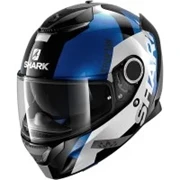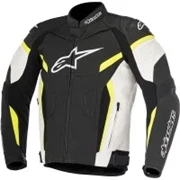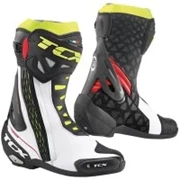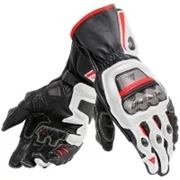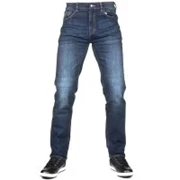Triumph Street Triple 675 Review (2007)
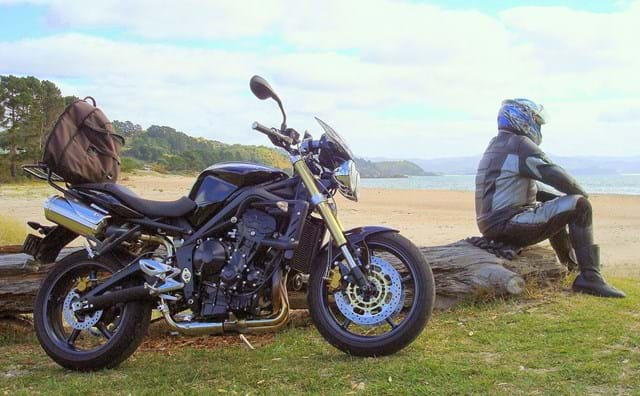
What Is It?
The Triumph Street Triple is a mid-range naked style bike and is powered by a liquid cooled 674.8 cc triple engine, producing 105 bhp at 11,850 rpm and maximum torque at 9,750 rpm.
Specs
- Seat Height: Average (800 mm / 31.5 inches)
- Weight: Average (188 kg / 415 lbs)
- Economy: Average (40 mpg / 7.1 l/100km / 14.2 km/l)
- Range: Average (150 miles / 241 km)
- Power to Weight: High (0.559 bhp/kg / 0.416 kW/kg)
- Top Speed: High (140 mph / 225 km/h)
Pros
- Wheelies
- Handling
- Value
Cons
- Suspension
- Lights
What Is It Like?
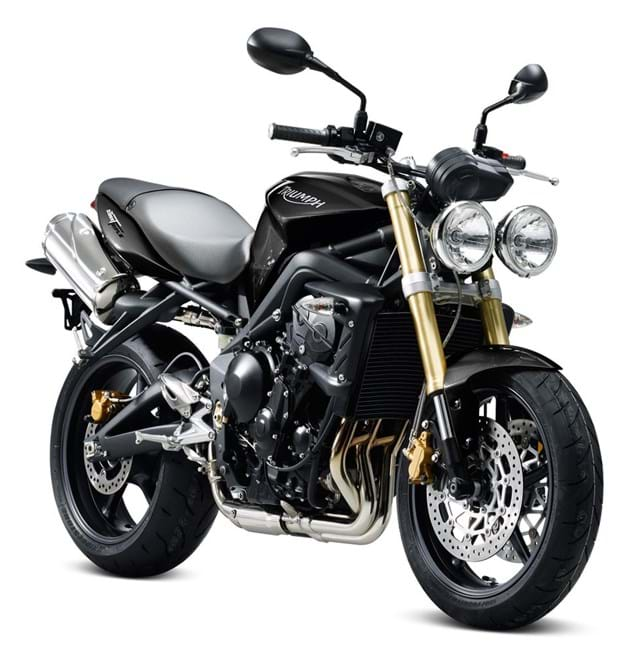
Choosing The Street Triple
In 2009 I changed from my much-loved Honda CBR1100XX Blackbird after 8 years of ownership to a Street Triple. Having now covered over 5,000 miles over a wide range of riding conditions, from the perspective of 40 years riding experience, I thought it might be interesting to quickly review the triple.
The "fitness for purpose" of any bike completely depends on what individual owners are looking for at the time and the criteria for replacing the Blackbird were not straightforward.
I turned 62 in October 2009 and at only 5' 8" tall, the Blackbird with its raised rear ride height, 250 kg wet weight and high centre of gravity was becoming more noticeable (and risky) at low speeds and parking. This was exacerbated by moving permanently to our beach property which is on the side of a hill and has lots of off-cambers and slopes - had some close calls with the 'bird!
Therefore, any replacement had to be lower, lighter and it came as a surprise just how many bikes ruled themselves out due to these aspects alone. I didn't want another faired sports bike as there wasn't sufficient differentiation compared with the 'bird but it still had to have plenty of performance as my riding partners like to "press on a bit" on occasions and come to that, so do I!
However, I wasn't overly concerned with an insane top speed as much of my riding is now on twisty coastal roads; so torque and handling is more of a consideration. Two-up riding for any distance wasn't a factor any more as my pillion prefers the comfort of her tricked-up MX-5 nowadays.
A shortlist was drawn up, dealers visited and bikes tested. I was nostalgically leaning towards Triumphs anyway as that was my brand of choice over 40 years ago but seeing the Street Triple in the flesh, let alone test riding it made that oh-so-important emotional connection which is critical for a lasting relationship. The test ride merely confirmed it so that was that and a Street Triple graced the shed in double-quick time!
Ergonomics
Within 5 minutes of getting on a Triple for the first time, it became clear that it was the most comfortable bike I'd ever ridden. My hands and feet instinctively went to where the controls were positioned and that gave instant confidence. That doesn't mean it's going to be perfect for everyone but suggests that unless you're at the extreme ends of the human dimension bell-curve; you're going to be pretty pleased.
The positioning of the bars means that the wrists are lightly loaded, perfect for a long haul. The reasonably upright stance gives great all-round visibility which considerably aids situational awareness - a worthwhile safety bonus.
I tried a Ducati Monster as part of the selection process and whilst I didn't bother with specific measurements, looking at the instrument cluster on the Monster seemed to require a deliberate downward movement of the head from the normal riding position as opposed to the quick flick of eyes on the Triple.
On the periphery of ergonomics, the light weight of the bike lessens fatigue on twistier roads and the relatively low seat height provides a bit more security for people with short legs like me when manoeuvring at low speeds, especially on roadside steep cambers.
Dash
Instrumentation is easy to see and excellent at night although changing the display on the run takes a lot of care. Resetting the trips can only be done whilst parked up, which is when you'd normally want to do them anyway.
Oh, and a small black mark on the report card. A corner of of the instrument cluster mists up very slightly after having been on the road for half an hour or so. It's not intrusive so I haven't complained but this issue has also been reported on Triple forums.
Seat
The stock seat is actually more comfortable than the standard Blackbird seat and that curve seems to allow you to move about sufficiently to vary any pressure points. 450 mile days have been achieved with no discomfort so far but for our October 1,000 miles in 24 hours endurance ride, some prior experimentation using large cell bubble wrap to temporarily change the profile is likely to be on the cards.
Seat (dis)comfort is often discussed on Triple forums but an individual's weight, shape and personal padding is likely to have just as much influence as the seat design itself. The Airhawk pneumatic pad is the best comfort aid ever.
Protection
The lack of a screen, or having a minimalist one can mean increased fatigue at speed on a long haul compared with a faired bike but the excellent riding position doesn't make it as bad as you might first think.
The wind blast on the body is nowhere near as fatiguing as the load on my wrists and forearms was when riding the Blackbird over seriously long distances. In fact, the wind blast is almost a positive thing in lessening load on the wrists and arms.
Two Up
Well, the height of the rear pegs are hardly designed for pillion comfort over long distances but that wasn't a criterion for me anyway.
However, a pillion passenger is unlikely to thank you without regular stops. Being two-up is getting away from the fundamental purpose of the Triple though.
Performance
I adored the deceptively brutal acceleration of the 'bird which is akin to going into warp drive but again, the number of times that the throttle has been pinned against the stop for long through the gears was pretty infrequent because of the roads I mainly travel on.
I think that it was the great Kenny Roberts who said that he preferred the GSX-R750 on the road to the GSX-R1000 because he could use more of its capability. If he said that, then big bikes are pretty much overkill for the rest of us mere mortals.
The reality is that I haven't missed the insane top end of the Blackbird because equal, if not more satisfaction has been gained from carrying higher speeds in the tight stuff and the generally better agility of the Triple. It's also good fun to occasionally hunt down bigger, heavier bikes in the twisties!
Aerodynamics at higher speeds made their presence felt and any performance difference between them could be largely measured in tiny percentages; which is negligible under normal road conditions. Top speed is still more than sufficient for instant license loss in most countries anyway!
Flexibility
Unlike "race replica" 600's which by comparison only deliver strong power higher in the rev range, the Triple starts delivering big lumps of torque not far off idle. Around 85% of max torque at 3,000 rpm if I remember correctly. For road riding in particular, this gives a huge advantage.
Firstly, it means that you're unlikely to get caught out in the wrong gear when wanting to make a rapid overtake. Secondly, the low-down torque means that it is very comfortable pootling along in traffic at low revs, but will respond instantly if need be.
The flexibility of the motor makes it the perfect bike for experienced riders and less-experienced ones alike. The only negative aspect from my perspective was a pronounced snatch when opening up from a trailing throttle during early ownership.
Interestingly, this has significantly reduced over time. Part of it may be due to the motor bedding in, part of it may be due to a more sensitive right wrist but in any event it's no longer intrusive.
Handling
In a word, exceptional! The light weight, fairly aggressive steering geometry, short wheelbase and fantastic riding position adds up to a bike which can change line almost by thought alone and if you make a balls-up of a corner entry, it's sufficiently forgiving to give you leeway to put it right. The Blackbird with its greater mass was far less forgiving of rapid corrections in the tight stuff with entry and exit requiring greater precision and planning.
Corner speed in the tight stuff on the local roads I know intimately is noticeably higher than on the Blackbird. On rougher surfaces when cornering, the Blackbird was definitely more planted due to a more conservative geometry but in particular, top of the line aftermarket suspension.
The Triple tends to jump around a bit more, but not in a really disconcerting way. Clearly, the stock suspension is built to a price and damping is pretty average but there is no intention to replace it with a more upmarket option until performance noticeably declines.
Under really heavy braking, the rear tyre has a tendency to unload when riding solo but as most of the braking effort is through the front wheel, it's not a big deal although it can be slightly disconcerting the first time the rear tyre leaves the ground!
A little more care is also required with heavy braking in wet conditions as it's comparatively easy to lock up the rear, not that this causes any real problems.
If you do get into trouble as I did when unexpectedly encountering a road surface that had been dug up, you're more likely to get away with it on a light, responsive bike like the Triple than with the mass of something like the Blackbird swinging about.
Lighting
The standard headlights are the only really disappointing aspect of owning a Street Triple. If your night riding is restricted to riding around town or maybe on well-lit major roads, it might just be adequate.
For unlit, twisty open road riding, it most certainly isn't. For starters, the lights are set way too low but properly adjusting them only takes a few moments.
The spread of light is fine for covering the roadside verges as well but the actual level of illumination is poor. I upgraded to the Ring Xenon Ultima +120 bulbs.
Farkles
- Triumph hugger
- Barracuda Italian screen
- Cox Racing Products radiator guard
Grin Factor
The Triumph Street Triple has won numerous international Bike of the Year awards since its launch and continues to do so. Owners and journalists everywhere talk about it being a larrikin of a bike with a f**k you attitude. Even at over 60 years of age, I agree wholeheartedly with these sentiments but what do those phrases really mean in more definable terms?
After thinking long and hard, it might be a combination of several things. The engine delivers instant power across the rev range and combined with the bike's light weight, this means that it's a seriously potent weapon.
Add the sublime handling to the mix and you've got something which is utterly confidence-inspiring and can keep you out of trouble where some other bikes will bite back. This means that the rider might go just that bit harder! I guess it's these features more than anything which allows the rider to have a lot of fun with a fair degree of safety.
Then there's the growl from the airbox when the throttle is tweaked. The sound is not obvious to bystanders but guaranteed to get the rider's hormones sloshing around, even for an old fart like me. If it could be bottled, Viagra would lose all sales to it overnight!
Let's not forget the less-experienced rider though. Those very same features and flexibility of the motor give you a comfortable and safe ride even if using a sizeable percentage of its performance is not currently your thing. Pillion-carrying limitations and below-par lighting aside, it must be close to the ideal bike for an awful lot of riders.
Mods
As of April 2015, the Street Triple has covered over 38,500 miles. The rectifier has been replaced as part of a no-cost recall, the mirror stalks replaced under warranty due to rusting and that's it other than replacing the OEM rear shock with a higher spec Nitron one.
To Sum Up
I doubt that I'll be selling it anytime soon. It wouldn't be stretching the truth to say that the Street Triple has revitalised my riding enjoyment!
Would I buy another one? Absolutely, it fills everything I currently want in a bike!
- Geoff J, 2016
Price Guide
Related Bikes
Triumph Street Triple 675 (2012-2016) - New and improved version.
Add Your Review
Do you own this bike? We would love to hear anything good, bad, unexpected or that you have changed plus anything that a prospective new owner might find interesting or useful.


